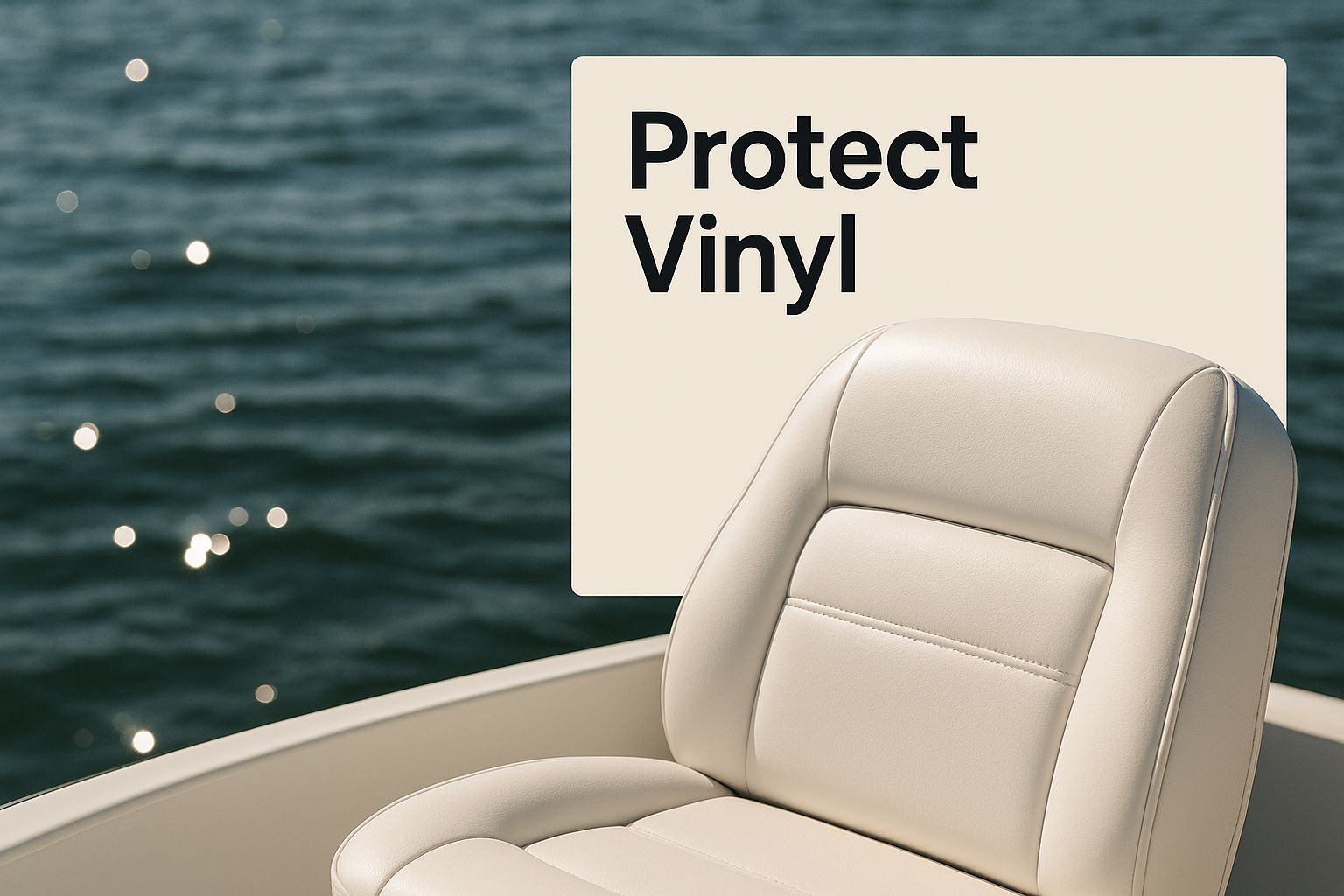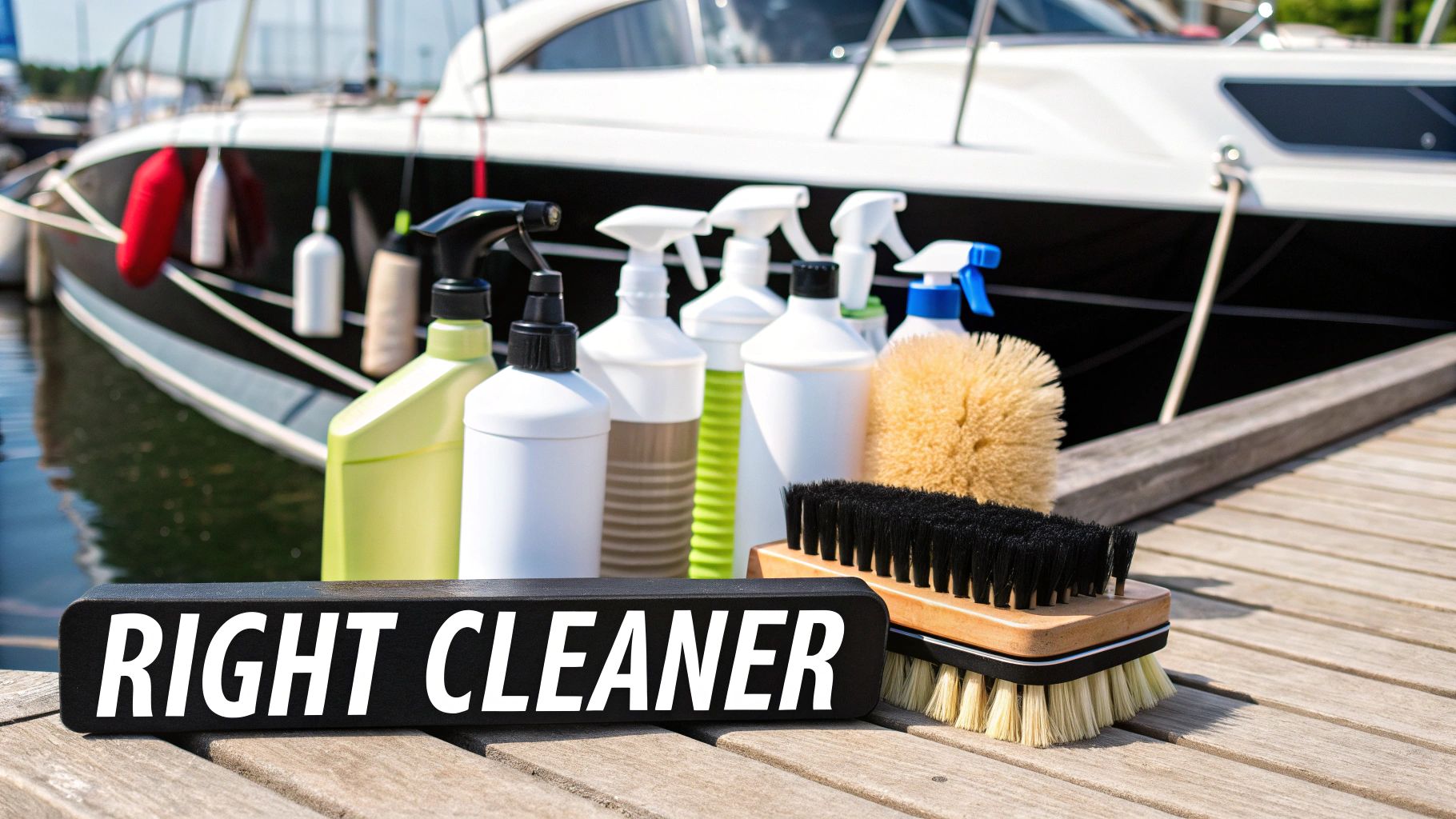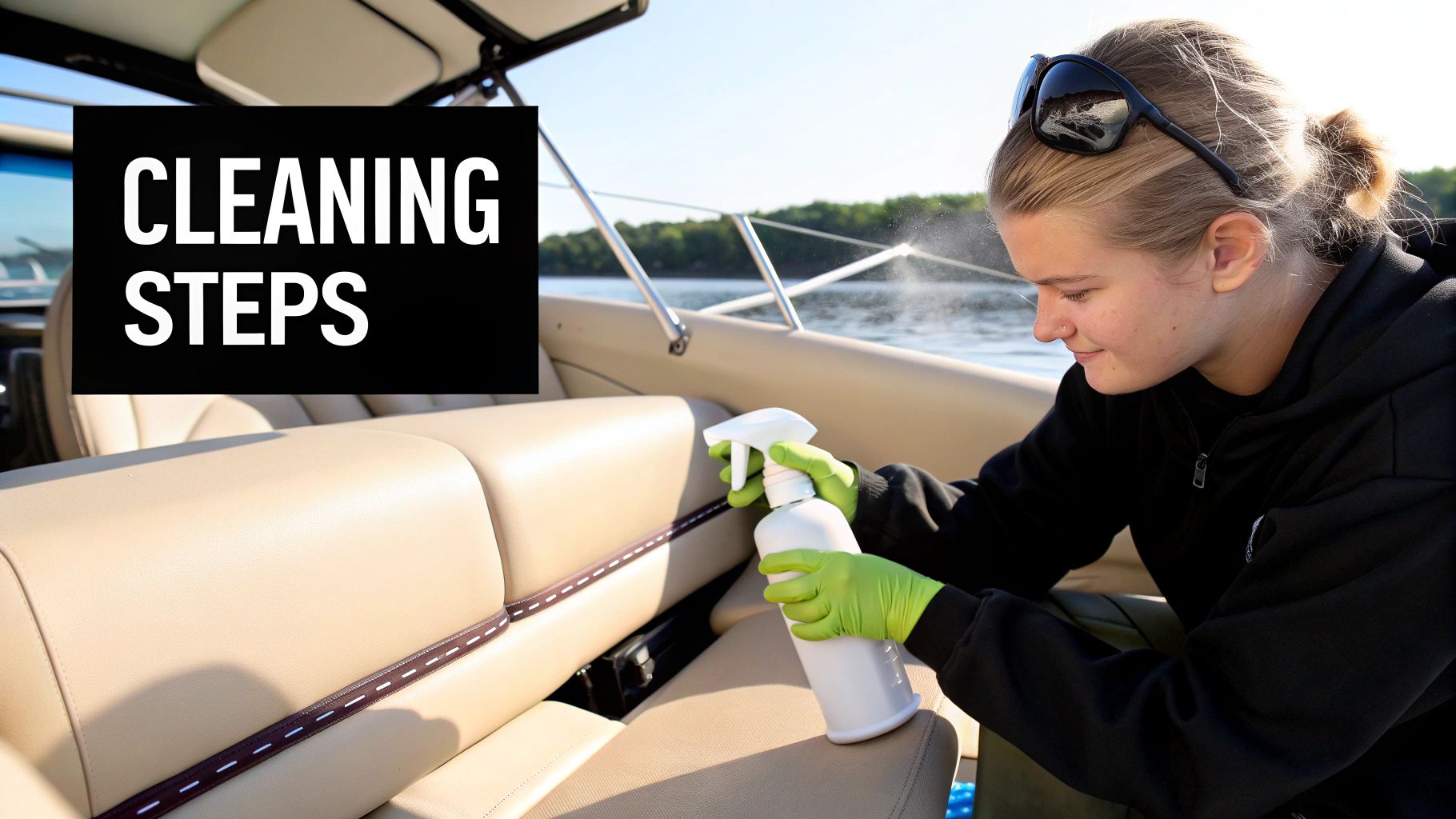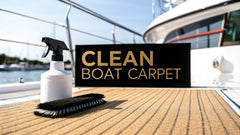Best Vinyl Cleaner for Boats Your Ultimate Guide
When you're hunting for the absolute best vinyl cleaner for your boat, you want a dedicated marine-grade formula that hits a few key marks. It needs to be pH-neutral, packed with robust UV inhibitors, and completely free from harsh chemicals like bleach or ammonia. A top-shelf product won’t just lift stubborn stains like mildew and sunscreen; it will also shield your upholstery from the sun's relentless assault, stopping cracking and fading in their tracks.
Why Your Boat’s Vinyl Needs More Than Just a Wipe Down
That crisp, white vinyl on your boat seats is practically a symbol of good times on the water. But the very things you love most about boating—the sun, the salt, the spray—are in a constant battle with your upholstery. Thinking a quick wipe-down is enough is like believing a simple rinse will stop your car's paint from rusting. It just won't cut it.
Marine vinyl is tough stuff, built for a demanding environment, but it isn't bulletproof. Unlike the couch in your living room, it faces a non-stop barrage of stressors that can break it down in a surprisingly short amount of time. Taking proper care of it isn't just another chore on the list; it's a critical part of protecting your boat's value and your pride of ownership.
The Unseen Enemies of Marine Vinyl
There are a few key culprits constantly working to turn your pristine cushions into a cracked, discolored mess. You need to know what you're up against:
- UV Radiation: The sun is public enemy number one. It relentlessly breaks down the vinyl’s plasticizers—the compounds that keep it soft and flexible. This leads directly to that faded, brittle look and eventually, to ugly cracks.
- Salt and Moisture: When saltwater dries, it leaves behind abrasive salt crystals that grind away at the vinyl's surface. At the same time, all that moisture creates the perfect breeding ground for mold and mildew to take hold.
- Stains and Spills: Sunscreen, spilled drinks, fish blood, and everyday grime can easily soak into the vinyl's porous surface, leaving behind permanent stains if you don't tackle them quickly and correctly.
A specialized marine vinyl cleaner is formulated to combat these specific threats. It does more than just clean—it actively defends, protects, and revitalizes your investment against the harsh marine environment.
This infographic really drives home how important it is to protect your boat's vinyl from the elements to keep it looking sharp and lasting for years.

As the image shows, being proactive is the key to avoiding costly repairs or a full reupholstering job down the road. This focus on preservation is a big deal, and it's driving serious growth in the market. Back in 2025, the boat vinyl cleaner market was already estimated at $500 million, and it's projected to grow at a steady 6% annually through 2033.
This principle of consistent care really applies everywhere. Just as your boat's vinyl needs regular attention, understanding the importance of routine upholstery cleaning for your home furniture highlights the universal benefits of proper maintenance.
Understanding the Ingredients in Your Vinyl Cleaner
Picking the right vinyl cleaner for your boat is a bit like choosing a good face wash. Some ingredients are nourishing and protective, while others are so harsh they end up doing more harm than good. To really protect your investment, you’ve got to look past the fancy claims on the bottle and get a feel for what’s actually inside.
Think of your boat's vinyl as having its own protective skin—a clear topcoat, kind of like what's on your car's paint job. The right cleaner will gently lift away the dirt, grime, and sunscreen residue without stripping that essential layer. The wrong one? It'll attack that topcoat, leaving your upholstery exposed and vulnerable to the elements.
The Heroes of Your Cleaner
When you’re scanning an ingredient list, there are a few "good guys" you want to see. These are the components that get the job done right, cleaning effectively while preserving the life and look of your marine vinyl.
- pH-Neutral Surfactants: These are the gentle giants of the cleaning world. Instead of using brute chemical force, they work by lowering the surface tension of water, which helps it slide under dirt and lift it away without damaging the vinyl itself.
- UV Inhibitors: This is a non-negotiable for any marine cleaner. The best ones leave behind a microscopic layer of UV protection that acts like a powerful sunscreen for your seats, deflecting the sun's damaging rays that cause fading, brittleness, and cracking.
- Conditioners and Plasticizers: Over time, the sun bakes the essential oils right out of your vinyl. These ingredients put that moisture back, keeping the material soft, flexible, and far less likely to split at the seams.
It's no surprise that as boat owners get savvier, the demand for smarter formulations is on the rise. We're seeing a big push for cleaners that can handle the toughest parts of the marine environment—stubborn mildew, UV damage, and salt spray—while also being eco-friendly. If you're interested in where things are headed, you can read more about these market innovations to understand the future of boat care.
The Villains to Avoid at All Costs
Knowing what to look for is only half the battle; you also need to know what to run from. Plenty of common chemicals, especially those found in household cleaners, will absolutely wreck your boat’s vinyl, leading to expensive repairs or a full replacement down the road.
Here's a simple rule of thumb: If a cleaner is harsh enough to irritate your skin, it's definitely too harsh for your boat's vinyl. That upholstery is more sensitive than you might think.
Always check the label and steer clear of any product that lists these troublemakers:
- Bleach (Sodium Hypochlorite): Sure, it kills mildew, but bleach is a corrosive chemical that strips vinyl of its plasticizers. The end result is yellowed, brittle, and weak fabric that's just waiting to crack.
- Alcohol and Ammonia: You'll find these in tons of glass and all-purpose cleaners. They are powerful solvents that dry out vinyl in a hurry, leading to premature cracking and fading.
- Petroleum Distillates: Often found in heavy-duty degreasers, these compounds can literally dissolve the vinyl’s protective topcoat. Once that's gone, your seats are an open target for stains and sun damage.
With so many ingredients to track, a quick cheat sheet can make all the difference when you're standing in the aisle.
Vinyl Cleaner Ingredient Cheat Sheet
Here's a quick-reference guide to help you instantly spot the good, the bad, and the ugly on any cleaner label.
| Ingredient Type | What It Does (The Good) | What to Avoid (The Bad) |
|---|---|---|
| Cleaning Agents | pH-Neutral Surfactants: Gently lift dirt and grime without stripping protective coatings. Safe for regular use. | Bleach, Ammonia, Alcohol: Harsh solvents that dry out vinyl, cause discoloration, and make it brittle over time. |
| Protection | UV Inhibitors: Act like sunscreen for your vinyl, blocking harmful rays that cause fading and cracking. | Petroleum Distillates: Aggressively strip away the vinyl's factory topcoat, leaving it exposed and vulnerable. |
| Conditioning | Plasticizers & Conditioners: Replenish lost moisture, keeping the material soft, supple, and resistant to splitting. | Abrasive Additives: Micro-scrubbers that can scratch and dull the vinyl surface, creating entry points for dirt. |
By learning to spot these heroes and villains, you can confidently choose the best vinyl cleaner for boats—one that not only makes your seats look great today but actively preserves them for many more seasons on the water.
Choosing Your Cleaner All-Purpose vs Heavy-Duty

Let's be honest, not every mess on your boat is the same. Grabbing a heavy-duty formula for a quick wipe-down is like using a sledgehammer to hang a picture frame—it’s way too much for the job and you might do more harm than good. But when you’re staring down deep-set mildew from a long winter in storage, a light all-purpose spray just won't cut it.
Knowing the difference between your cleaners helps you build a smarter cleaning kit. It’s all about matching the right product to the job at hand, so your vinyl gets clean without getting damaged by harsh chemicals. This approach doesn't just work better; it adds years to the life of your expensive upholstery.
All-Purpose Sprays for Routine Upkeep
Think of your all-purpose marine vinyl cleaner as your go-to, everyday workhorse. This is the bottle you’ll grab after a day on the water to get rid of light dirt, fresh spills, and that ever-present saltwater spray. These formulas are made to be gentle enough for frequent use, cleaning away the daily grime without stripping the vinyl's important protective layers.
A good all-purpose spray is perfect for:
- Wiping down seats to get rid of sunscreen residue after guests head home.
- Cleaning up a spilled soda before it has a chance to get sticky and stain.
- Rinsing away salt spray to stop those abrasive crystals from scratching up the surface.
These cleaners are your first line of defense, keeping small issues from turning into big, stubborn problems. They're the foundation of any solid vinyl care routine.
Heavy-Duty Cleaners for Tough Jobs
When you pull off the boat cover after winter and find ugly mildew spots creeping into the seams, your all-purpose spray isn't going to be enough. This is when a heavy-duty cleaner steps in to save the day. These are stronger, more concentrated formulas designed to break down the really stubborn, deep-set stains.
A heavy-duty cleaner has the muscle to tackle tough stuff like mold and mildew, lifting it right out of the vinyl’s texture. But because they're so powerful, you should only use them when you really need to, to avoid putting too much stress on the material.
These potent cleaners are ideal for your big seasonal deep cleans or for bringing neglected upholstery back to life. After you use a heavy-duty product, always remember to rinse the area well and follow up with a quality UV protectant to restore the vinyl's defensive shield.
Cleaner and Protectant Combos for Efficiency
For boat owners who like to keep things simple, a combination cleaner and protectant is a great two-in-one solution. These products clean away light to moderate dirt and leave behind a thin layer of UV inhibitors and conditioners all at once. They're an excellent choice for regular maintenance between your more intensive cleaning sessions.
They might not pack the same punch as a dedicated heavy-duty cleaner or offer the same bulletproof defense as a separate protectant, but you can't beat their convenience for quick touch-ups.
For a reliable option that balances gentle cleaning with crucial protection, check out our specially formulated marine vinyl cleaner. It’s designed to be tough on dirt but safe for your boat’s upholstery, making it a super versatile tool in your cleaning arsenal.
Key Factors for Selecting the Best Vinyl Cleaner
Picking the right vinyl cleaner for your boat is about more than just wiping away dirt. Think of it like buying sunscreen. You don't just grab any bottle; you look for specific features like SPF and water resistance. The right cleaner acts as a complete defense system for your valuable upholstery.
To make a smart choice, there are a few non-negotiable features you need on your checklist. These elements work together to not only clean your vinyl but to preserve and protect it from the brutal marine environment. Without them, a cleaner that seems to work fine at first could be letting serious long-term damage slip right by.
Robust UV Protection Is a Must
The sun is, without a doubt, the number one enemy of your boat’s vinyl. Its relentless UV rays attack the essential plasticizers that keep the material soft and flexible. The result? Fading, brittleness, and eventually, a mess of ugly cracks. A top-tier cleaner absolutely must contain powerful UV inhibitors.
These ingredients form an invisible shield on the vinyl's surface, deflecting that harmful radiation before it can do damage. This is the single most important defense against premature aging and is the real difference between upholstery that lasts five seasons and upholstery that looks tired after just one.
Look for Effective Mildew Resistance
Moisture is a constant companion on any boat, and that creates the perfect breeding ground for mold and mildew. These fungi don’t just leave behind gross black and green stains; they can literally eat away at your vinyl and its stitching over time.
The best vinyl cleaner for boats will have mildew-fighting agents built right in, or at least be formulated to create a surface where fungus can't easily take hold. This proactive feature stops mildew in its tracks, saving you from aggressive scrubbing and potential damage later on. It’s a simple step that keeps your seats looking and smelling fresh.
Choosing a product with built-in protective qualities is a strategic investment. The global marine vinyl market is projected to hit USD 488.0 million by 2030, driven by boat owners demanding better, more durable materials. Protecting that high-quality vinyl with the right cleaner is essential to maintaining your boat's value.
A Balanced pH for Safe Cleaning
The pH level of a cleaner tells you how acidic or alkaline it is. Cleaners with a harsh, unbalanced pH can chemically burn your vinyl, stripping away its protective topcoat and causing permanent discoloration. This is why you should always look for a pH-neutral formula.
A balanced cleaner is strong enough to lift away dirt, grime, and oils but gentle enough that it won't harm the vinyl itself or the delicate stitching holding your seats together. This ensures you can clean regularly without causing cumulative damage.
Compatibility with Stitching and Other Materials
Remember, your boat seats aren't just vinyl. They’re a whole system of materials, including thread, zippers, and sometimes adjacent fabrics or plastics. A great cleaner is one that’s safe for all of them. Harsh chemicals are notorious for weakening and rotting the thread in your seams, which can lead to your cushions literally falling apart.
Before you buy, double-check that the product is rated as safe for marine-grade thread and surrounding components. The key is finding a cleaner that combines all these factors—UV defense, mildew resistance, balanced pH, and material compatibility. For a truly comprehensive approach, consider adding specialized cleaners like this to a complete boat cleaning kit to cover all your bases.
Your Step-by-Step Guide to Perfect Vinyl Cleaning

Knowing what the best vinyl cleaner is only half the battle. Actually using it the right way is how you get those flawless, long-lasting results. Professional detailers get that showroom finish not by scrubbing harder, but by following a smart, methodical process.
We’re going to break down that exact process into simple, repeatable steps. It's time to clean your upholstery with confidence. Using the right technique does more than just make your seats look good for a weekend—it actually extends the life of your expensive vinyl. It’s all about working with the material, not against it, to lift away grime without causing any harm.
Preparation Is Everything
Before you even think about spraying the cleaner, a few moments of prep work will make a world of difference. First things first: try to work in the shade or on an overcast day. Direct sunlight is the enemy here; it can make cleaners evaporate way too fast, leaving behind a sticky film and ugly streaks.
Next, give the vinyl a quick rinse with some fresh water. This simple step knocks off all the loose stuff like dirt, salt crystals, and other debris. That way, your cleaner can get straight to work on the stubborn, ground-in grime.
The Professional Cleaning Method
With the surface prepped, it's time to get down to business. The real secret is to work in small, manageable sections—think one cushion or a single seat back at a time. This keeps the product from drying out before you've had a chance to work it in and wipe it away.
- Application: Spray your chosen marine vinyl cleaner directly onto one section. You don’t have to be shy, but avoid completely soaking the area. A nice, even coat is what you're after.
- Agitation: Grab a soft-bristled brush and gently agitate the cleaner using small, circular motions. This is key for lifting dirt out of the vinyl’s texture and seams without scratching the surface. For a great visual, our guide on how to clean vinyl boat seats shows this exact technique in action.
- Wipe and Lift: Once the grime is loosened up, use a clean, damp microfiber towel to wipe away both the cleaner and the dirt. You’ll be amazed at the gunk that transfers right onto the cloth.
- Rinse Thoroughly: This is a crucial step that so many people skip. Take a separate towel dampened with fresh water and wipe the area again. This removes any lingering cleaner residue that could attract more dirt later.
- Dry Completely: Finally, grab a dry microfiber towel and buff the surface. This prevents water spots from forming and leaves you with a clean, non-greasy finish that looks fantastic.
Pro Tip: Always, always test a new cleaner on a small, hidden spot first, like the underside of a cushion. This is your insurance policy against discoloration or damage before you tackle a highly visible area.
By following this step-by-step approach, you'll nail a professional-level clean every single time. It's worth noting that many of these principles apply to any kind of vinyl care. For more general tips, resources on cleaning vinyl car seats can offer some great transferable advice that's useful for any vinyl surface you own.
Common Questions About Boat Vinyl Care
Even when you think you've got the hang of it, questions always seem to pop up when it comes to keeping your boat's vinyl looking sharp. Getting the right answers is key—a wrong move can lead to some seriously expensive damage. We'll tackle some of the most common questions we hear to help you take care of your upholstery like a pro.
Think of this as your go-to FAQ for keeping those seats looking brand new. From busting myths about what you can use in a pinch to figuring out a realistic cleaning schedule, we've got you covered.
Can I Use Household Cleaners on My Boat Seats?
This is probably the single most common question we get, and the answer is a hard no. It can be tempting to grab whatever is under the sink, but things like bleach, ammonia-based sprays, or even a magic eraser will do irreversible damage to marine vinyl. It’s a shortcut you’ll end up paying for down the road.
Why? Well, a harsh chemical like bleach literally attacks the plasticizers that keep your vinyl soft and flexible. It strips them right out, leading to yellowing, brittleness, and eventually, a web of ugly cracks. A magic eraser is just as bad; it acts like super-fine sandpaper, scrubbing away the vinyl's protective topcoat. Once that shield is gone, your seats are wide open to future stains and UV damage. Always, always stick to a product made to be the best vinyl cleaner for boats.
How Often Should I Clean My Boat Vinyl?
Honestly, the perfect cleaning schedule depends on how much you use your boat and where you're boating. For the best results, a quick wipe-down with a gentle, pH-neutral marine cleaner after every trip is a fantastic habit to get into, especially if you're out on the salt. It stops salt crystals from turning into tiny sand-like abrasives and keeps fresh spills from becoming permanent stains.
Beyond that daily wipe, you should plan for a more thorough deep cleaning every 3-4 months during your prime boating season. This is when you'll break out a dedicated cleaner and follow it up with a fresh application of a quality UV protectant.
Pro tip: A complete clean-and-protect session is a must-do right before you put the boat away for the winter and again as soon as you pull it out for the spring. This routine is your best defense against mildew and sun damage during the off-season.
Is a Cleaner and Protectant Combo Good Enough?
Those all-in-one products that clean and protect in a single step are great for routine upkeep. They are absolutely perfect for those quick wipe-downs after a day on the water and are a whole lot better than doing nothing at all. They give you a nice balance of efficiency and basic protection.
However, if you're looking for the toughest, longest-lasting defense against the elements, a separate two-step process is the way to go. Using a dedicated cleaner first gets the surface completely free of dirt, grime, and oils. This gives you a truly clean slate, allowing a separate, high-quality UV protectant to bond directly and more effectively to the vinyl. The result is a much stronger shield against the harsh marine environment.
Will a Cleaner Fix Small Cracks in My Vinyl?
Unfortunately, no. A cleaner just can't repair physical damage like cracks and tears. Cracks are a sign that the vinyl has already lost its flexibility and plasticizers. No amount of cleaning can reverse that kind of structural failure.
While a good cleaning and conditioning routine will definitely help nourish the surrounding vinyl—making it more supple and maybe even preventing existing cracks from getting worse—it can't fix what's already broken. For small issues, a dedicated vinyl repair kit is your best bet. For bigger problems, you'll want to talk to a professional upholstery service.
For a complete lineup of products designed to be tough on grime but safe for every part of your boat, trust Better Boat. Find the right cleaner and protectant for your boat today and keep your vessel in pristine condition, season after season.




